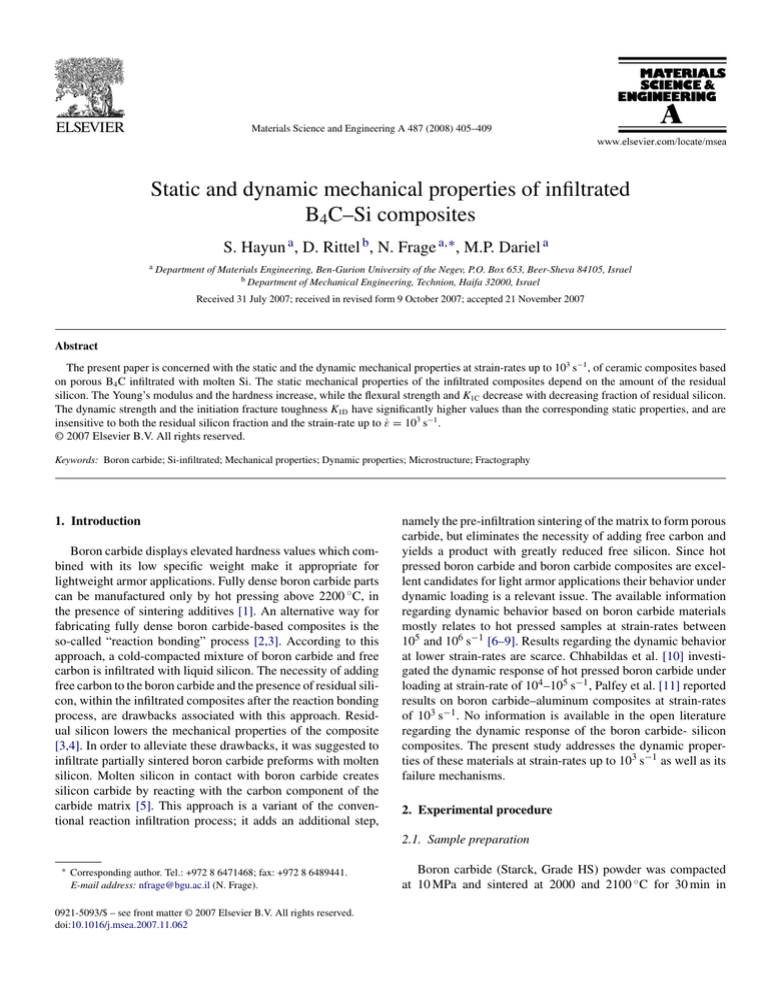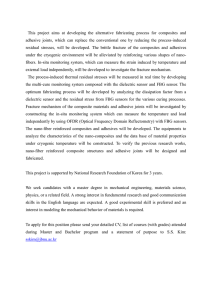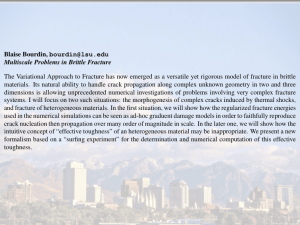
Materials Science and Engineering A 487 (2008) 405–409
Static and dynamic mechanical properties of infiltrated
B4C–Si composites
S. Hayun a , D. Rittel b , N. Frage a,∗ , M.P. Dariel a
a
Department of Materials Engineering, Ben-Gurion University of the Negev, P.O. Box 653, Beer-Sheva 84105, Israel
b Department of Mechanical Engineering, Technion, Haifa 32000, Israel
Received 31 July 2007; received in revised form 9 October 2007; accepted 21 November 2007
Abstract
The present paper is concerned with the static and the dynamic mechanical properties at strain-rates up to 103 s−1 , of ceramic composites based
on porous B4 C infiltrated with molten Si. The static mechanical properties of the infiltrated composites depend on the amount of the residual
silicon. The Young’s modulus and the hardness increase, while the flexural strength and K1C decrease with decreasing fraction of residual silicon.
The dynamic strength and the initiation fracture toughness K1D have significantly higher values than the corresponding static properties, and are
insensitive to both the residual silicon fraction and the strain-rate up to ε̇ = 103 s−1 .
© 2007 Elsevier B.V. All rights reserved.
Keywords: Boron carbide; Si-infiltrated; Mechanical properties; Dynamic properties; Microstructure; Fractography
1. Introduction
Boron carbide displays elevated hardness values which combined with its low specific weight make it appropriate for
lightweight armor applications. Fully dense boron carbide parts
can be manufactured only by hot pressing above 2200 ◦ C, in
the presence of sintering additives [1]. An alternative way for
fabricating fully dense boron carbide-based composites is the
so-called “reaction bonding” process [2,3]. According to this
approach, a cold-compacted mixture of boron carbide and free
carbon is infiltrated with liquid silicon. The necessity of adding
free carbon to the boron carbide and the presence of residual silicon, within the infiltrated composites after the reaction bonding
process, are drawbacks associated with this approach. Residual silicon lowers the mechanical properties of the composite
[3,4]. In order to alleviate these drawbacks, it was suggested to
infiltrate partially sintered boron carbide preforms with molten
silicon. Molten silicon in contact with boron carbide creates
silicon carbide by reacting with the carbon component of the
carbide matrix [5]. This approach is a variant of the conventional reaction infiltration process; it adds an additional step,
namely the pre-infiltration sintering of the matrix to form porous
carbide, but eliminates the necessity of adding free carbon and
yields a product with greatly reduced free silicon. Since hot
pressed boron carbide and boron carbide composites are excellent candidates for light armor applications their behavior under
dynamic loading is a relevant issue. The available information
regarding dynamic behavior based on boron carbide materials
mostly relates to hot pressed samples at strain-rates between
105 and 106 s−1 [6–9]. Results regarding the dynamic behavior
at lower strain-rates are scarce. Chhabildas et al. [10] investigated the dynamic response of hot pressed boron carbide under
loading at strain-rate of 104 –105 s−1 , Palfey et al. [11] reported
results on boron carbide–aluminum composites at strain-rates
of 103 s−1 . No information is available in the open literature
regarding the dynamic response of the boron carbide- silicon
composites. The present study addresses the dynamic properties of these materials at strain-rates up to 103 s−1 as well as its
failure mechanisms.
2. Experimental procedure
2.1. Sample preparation
∗
Corresponding author. Tel.: +972 8 6471468; fax: +972 8 6489441.
E-mail address: nfrage@bgu.ac.il (N. Frage).
0921-5093/$ – see front matter © 2007 Elsevier B.V. All rights reserved.
doi:10.1016/j.msea.2007.11.062
Boron carbide (Starck, Grade HS) powder was compacted
at 10 MPa and sintered at 2000 and 2100 ◦ C for 30 min in
406
S. Hayun et al. / Materials Science and Engineering A 487 (2008) 405–409
order to obtain preforms with 30 and 20 vol.% of total porosity
respectively. The preforms were infiltrated with molten silicon
at 1480 ◦ C in a vacuum of ∼10−4 Torr for 20 min. Preforms
with 20 and 30 vol.% porosity are denoted as S20 and S30,
respectively. The ground and polished samples for the dynamic
testing were typically 7 mm diameter and 3.5 mm thick. Bars
45 × 4 × 6 mm and 22 × 4 × 6 mm were used for fracture and
three point bending tests, respectively. As fatigue pre-cracking is
extremely difficult for these materials, sharp notches were introduced using a 0.2 mm thick diamond saw. It is believed that while
the sharp notch is not fully equivalent to a sharp crack, the error
is systematic so that the observed trends can be considered as
representative.
2.2. Microstructural investigation
The microstructure of the samples was studied by scanning electron microscopy (SEM, JEOL-35) combined with an
energy-dispersive spectrometer (EDS). The samples for SEM
characterization were prepared using a standard metallographic
procedure that included a last stage of polishing with 1 m
diamond paste. The phase composition of the infiltrated composites was determined by X-ray diffraction. (Rigaku RINT
2100). The residual Si fraction in the composites was determined
by analysis of SEM images using the Thixomet1 software. In
order to clarify the morphology of the SiC phase, residual Si
was removed by etching the polished samples in 10% HF for
30 s.
2.3. Mechanical properties
Hardness was determined using a Buehler microhardness
tester with a Vickers indenter under 20 N load. The flexural strength was determined by three-point bending test. The
velocities of longitudinal and transverse acoustic waves were
determined by the pulse-echo technique using a 5 MHz probe.
The elastic modulus was derived from ultrasonic velocity data
and the density values of the composites measured by the
Archimedes method. Dynamic compression stress–strain curves
were obtained by split Hopkinson (Kolsky) pressure bar testing
[12]. Quasi-static fracture testing was carried out on a MTS810
servo-hydraulic machine under displacement control. The loading configuration was that of the three-point bend testing. Since
all specimens displayed linear elastic behavior up to fracture,
the load at fracture was used for calculations of the fracture
toughness. Dynamic fracture testing was carried out using the
one-point impact configuration, as described in detail in previous
publications [13–15]. In order to probe the failure mechanism
under dynamic loading, the fracture path (profile) was investigated using nickel-plated specimens, from which mid-thickness
longitudinal sections were prepared through the main fracture
plane [16].
1 Image analysis program, developed at the St. Petersburg State Polytechnic
University, Department of Steel and Alloys.
Fig. 1. SEM image of the infiltrated composite, fabricated from the preform
with 20 vol.% of porosity.
3. Results and discussion
3.1. Microstructure of the infiltrated composites
The microstructure of the infiltrated B4 C composites (Fig. 1)
consists of three phases, namely boron carbide, -SiC and residual silicon. The -SiC phase appears as white plate-like particles.
The light-gray regions correspond to residual Si, and the dark
gray areas are the boron carbide phase. According to the image
analysis of the microstructure, the SiC phase constitutes about
13 and 17 vol.% and the residual Si 7 and 13 vol.% of samples
with an initial porosity of 20 and 30 vol.%, respectively. The
microstructure after etching and removal of the residual silicon
(Fig. 2) puts in relief the plate-like SiC phase, in some instances
still connected to the original boron carbide particles. The mechanism of the reaction between liquid Si and boron carbide has
been discussed previously [5].
Fig. 2. SEM image of the etched sample. The morphology of the SiC phase is
clearly apparent.
S. Hayun et al. / Materials Science and Engineering A 487 (2008) 405–409
407
Table 1
Static properties of the infiltrated composites
Materials
Density (g/cm3 )
Poisson’s ratio
E (GPa)
Hardness (GPa)
Flexural strength (MPa)
K1C (MPa m0.5 )
Residual Si (vol.%)
S20
S30
2.582 ± 0.060
2.606 ± 0.012
0.188 ± 0.004
0.189 ± 0.007
410 ± 9
370 ± 4
22.5 ± 1.4
20.3 ± 2.5
390 ± 70
415 ± 50
5.5 ± 2.2
7.9 ± 2.2
7.0
13.0
3.2. Static mechanical properties
The values of density, Young’s modulus, hardness and flexural strength of the infiltrated composites are presented in
Table 1. The two composites display relatively high hardness
and Young’s modulus values. Both the Young’s modulus and the
hardness increase, while the flexural strength and K1C decrease
with decreasing amounts of residual silicon. The high Young’s
modulus and hardness values are related to an increased fraction
of the ceramic phases within the composites.
In the course of the reaction between liquid Si and the boron
carbide preform devoid of free carbon, a plate-like SiC phase
with a high aspect ratio is formed [5]. A strengthening effect
of these plate-like SiC particles on ceramic composites was
reported in Refs. [17,18]. The SiC particle fraction in the S20
samples is lower (13 vol.%) than in the S30 samples (17 vol.%)
providing a clue for the increased flexural strength and fracture
toughness values in the latter.
Fig. 3. The two forces that act on the specimen, from the incident (F in) and the
transmitted (F out) side of specimen 5.
3.3. Dynamic mechanical properties
Since the investigated material is relatively hard and brittle,
a preliminary stage that leads to a valid stress–strain curve is to
assess the dynamic equilibrium of the specimen. Fig. 3 shows
the two forces acting on the specimen, from the incident (F in)
and the transmitted (F out) side of specimen 5 (Table 2). The
two forces are quite similar, almost from the onset of the tests,
indicating that the specimen is in dynamic equilibrium. This
condition was ascertained for each specimen, the mechanical
properties of which are reported here. The excellent dynamic
equilibrium shows that the Hopkinson bar test can be performed
in its classical form, without the need to resort to additional
techniques such as pulse-shaping.
The dynamic (initiation) fracture toughness was tested using
the one-point impact configuration. The specimen was in contact
with an instrumented (Hopkinson) bar. On the specimen, two
fracture gauges are cemented on each side of a sharp notch (in
this case). The load applied to the specimen was recorded using
the instrumented bar and the (mode I) stress intensity factor was
calculated from the onset of the loading process until the crack
starts to propagate (fracture), as indicated by the fracture gauges.
At this time, the calculated stress intensity factor is interpreted
Table 2
Dynamic mechanical properties of the infiltrated composites
Material
Diameter (mm)
Height (mm)
σ max (MPa)
ε̇, (s−1 )
Energy (MJ/m3 )
S20 composites
1
2
3
4
5
6
7.04
6.98
6.97
6.83
7.02
6.97
3.37
3.35
3.36
3.36
3.36
3.34
1070
1260
1280
1330
1290
1320
2250
5000
3700
3100
2850
2820
18
30
30
35
21
30
S30 composites
1
2
3
4
5
6
7
7.09
6.78
6.81
7.29
7.15
7.14
7.04
3.99
3.98
3.98
4.00
3.96
3.97
3.96
1430
1080
1100
909
1030
1090
1170
2300
1850
1882
1715
2116
1829
1987
26
17
17
12
17
13
19
408
S. Hayun et al. / Materials Science and Engineering A 487 (2008) 405–409
Fig. 6. Typical SEM image of quasi-statically fractured specimens.
Fig. 4. A typical record of a load–time curve along with the indications of
the fracture gauges. It is observed that fracture occurs significantly after the
peak-load, which is characteristic of this kind of test.
as the dynamic fracture toughness of the material. Two values
were usually measured, one on each side of the specimen, and
the test was considered as valid when these two values were
sufficiently close (within 15%), and after visual assessment that
the crack path was flat and not slanted, which would indicate a
mixed-mode fracture. A typical record of a load–time curve is
shown in Fig. 4 along with the indications of the fracture gauges.
The fracture occurred significantly after the peak-load, which is
characteristic of this kind of test.
Typical dynamic stress–strain curves are shown in Fig. 5 the
stress–strain curves suggest that the overall ductility to failure is
not sensitive to the composition variation within the samples that
were examined. The curves are mostly smooth but some oscillations appear before failure. These oscillations are probably
related to the failure mechanism, which we believe is associated
with the nucleation and coalescence of microcracks [19]. The
peak stress is taken as the characteristic dynamic failure stress
of the composite.
Fig. 5. Typical dynamic stress–strain curves.
The dynamic properties of the composites were determined
in the 1700–5000 s−1 strain-rate range (Table 2). The average
values of σ max were 1258 ± 95 and 1118 ± 138 MPa for the S20
and S30 samples, respectively. The experimental results indicate
that the infiltrated composites do not appear to be strain-rate
sensitive. A similar behavior of the B4 C–Al composites has
been reported by Palfey et al. [11], but the compressive fracture strength (σ max ) of these composites has been reported to be
higher (3800 and 2000 MPa for 80% B4 C–Al and 65% B4 C–Al
composites, respectively). This difference is to be attributed to
the extended plasticity of the aluminum-containing composites in contrast to the overwhelmingly brittle behavior of the
silicon-containing composite.
The measured values of the dynamic fracture toughness (K1D )
were 42.6 ± 17.6 and 117.8 ± 28.9 for the S20 and S30 samples, respectively. These values are significantly higher than
the K1C values, measured under static conditions. For brittle
materials, this finding is not surprising and it may result from
specific dynamic crack initiation mechanisms that do not operate at quasi-static rates, as shown in Ref. [16]. Although, the
dynamic fracture toughness (K1d ) of the S30 composites is
Fig. 7. Typical SEM image of dynamically fractured specimens.
S. Hayun et al. / Materials Science and Engineering A 487 (2008) 405–409
409
Fig. 8. Typical fracture path (profile) of samples after quasi-static (A) and dynamic (B) failure.
higher than that of the S20 composites, the average value of
the energy absorption up to failure for the S30 composites,
is 17.2 MJ/m3 while for the S20 composites it is significantly
higher (27.3 MJ/m3 ). The values of the dynamic fracture toughness reflect a crack initiation process, whereas the values of
the energy absorption are related to the overall failure process,
including dynamic crack propagation. Thus, these two toughness values provide an overall picture of the dynamic fracture
behavior of the composite.
3.4. Failure mechanisms
Typical fracture surfaces of specimens after quasi-static and
dynamic loading are shown in Fig. 6 and Fig. 7, respectively. In
both cases the operation of cleavage-like fracture mechanisms
was clearly detected. The static fracture takes place only along
one plane and may be attributed to the critical crack propagation (Fig. 8A), while the dynamic fracture occurs along several
distinct planes, in which a secondary set of cracks, denoted S,
appears to run parallel to the main fracture plane (M) (Fig. 8B).
4. Conclusion
Boron carbide composites with a reduced fraction of residual
silicon have relatively high values of hardness and Young’s modulus, but their flexural strength and fracture toughness decrease
with decreasing residual silicon. In the sample with higher initial porosity, a larger fraction of plate-like SiC was generated
leading to increased flexural strength and fracture toughness on
account of the strengthening effect of the high aspect ratio of the
second ceramic phase particles. The dynamic strength and the
dynamic fracture toughness K1d are significantly higher than the
corresponding static properties and are insensitive to the residual
silicon fraction and to the strain-rate (up to ε̇ = 103 s−1 ).
Acknowledgment
This work was partly supported by the Israel Science Foundation grant 118/03.
References
[1] F. Thévenot, J. Eur. Ceram. Soc. 6 (1990) 205–225.
[2] P. Popper, In Special Ceramics 1., British Ceramic Research Association,
London, 1960, pp. 209–219.
[3] K.M. Taylor, R.J. Palicke, U.S. Patent No. 3,765,300 (1973).
[4] M.K. Aghajanian, B.N. Morgan, J.R. Singh, J. Mears, R.A. Wolffe, in:
J.W. McCauley, et al. (Eds.), Ceramic Armor by Design, The American
Ceramics Society, Westerville, OH, 2002, pp. 527–539.
[5] S. Hayun, N. Frage, M.P. Dariel, J. Solid State Chem. 179 (9) (2006)
2875–2879.
[6] D.P. Dandekar, Report No. ARL-TR-2456 (2001).
[7] C. Mingwei, J.W. McCauley, J.K. Hemker, Science 299 (5612) (2003)
1563–1566.
[8] T.J. Vogler, W.D. Reinhart, L.C. Chabildas, J. Appl. Phys. 95 (8) (2004)
4173–4183.
[9] D.E. Grady, SAND 94-3266, Sandia National Laboratories (1995).
[10] L.C. Chhabildas, W.D. Reinhart, D.P. Dandekar, in: J.W. McCauley, et
al. (Eds.), Ceramic Armor Materials by Design, The American Ceramics
Society, Westerville, OH, 2002, pp. 269–278.
[11] W.J. Palfey Jr, D.A. Koss, W.R. Blumenthal, First International Conference
on Advanced Materials Processing, ICAMP 2000, 2000, pp. 19–23.
[12] H. Kolsky, Stress Waves in Solids, Dover Publications, New York, 1963.
[13] G. Weisbrod, D. Rittel, Int. J. Fract. 104 (1) (2000) 89–103.
[14] D. Rittel, N. Frage, M.P. Dariel, Int. J. Solid Struct. 42 (2) (2005) 697–715.
[15] D. Rittel, A.J. Rosakis, Eng. Fract. Mech. 72 (2005) 1905–1919.
[16] D. Rittel, Int. J. Fract. 106 (2) (2000) L3–L8.
[17] S.K. Lee, Y.C. Kim, C.H. Kim, J. Mater. Sci. 29 (20) (1994) 5321–
5326.
[18] W.J. Moberlychan, J.J. Cao, L.C.D.E. Jonghe, Acta Mater. 6 (5) (1998)
1625–1635.
[19] W.D. Kaplan, D. Rittel, M. Lieberthal, N. Frage, M.P. Dariel, Scripta Mater.
51 (1) (2004) 37–41.



